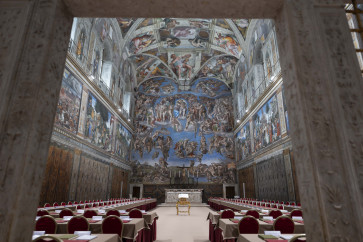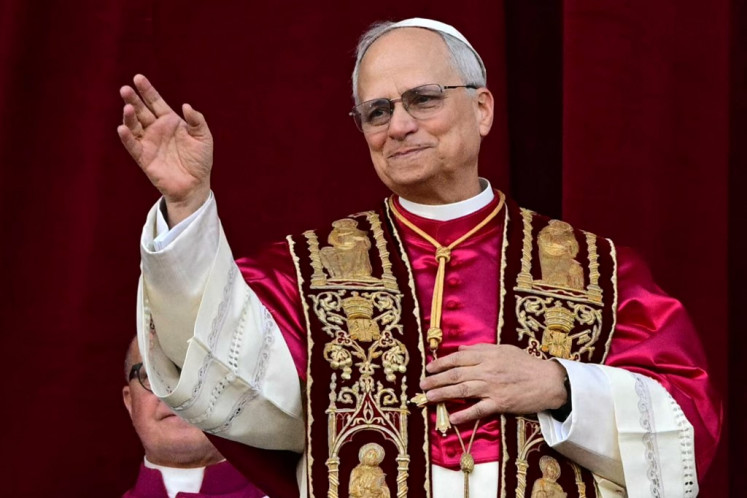Hotel Indonesia Kempinski: Sukarno’s trails in the heart of Jakarta
A classic view of Hotel Indonesia from the traffic circle fountain
Change text size
Gift Premium Articles
to Anyone

A classic view of Hotel Indonesia from the traffic circle fountain. (Courtesy of Hotel Indonesia Kempinski)
At 50-years-old, Hotel Indonesia continues to glitter.
Have you ever spent a classic night in the heart of Jakarta?
With the famous Hotel Indonesia traffic circle fountain as the backdrop, and as a busy evening turns into a calmer night, the perfect setting is created.
Imagine looking at that setting from Hotel Indonesia Kempinski, a luxurious hotel of 50 years that was reborn under the world-class Kempinski brand, a European hotelier since 1897.
Built on Aug. 5, 1962 as part of the country’s debut in hosting the Asian Games sporting event, Hotel Indonesia was Jakarta’s first starred hotel. It has been through so many eras, both as a witness to history and as a part of history itself.
At its 50th anniversary, the golden dame hasn’t wrinkled. Within Kempinski, Jakarta is introduced as well as memorabilia from Indonesia’s past with the merging of Indonesian and European arts by the skillful hand of the country’s first president, Sukarno.
The function room was once used for the Miss Indonesia pageant in 1969 and also for several important events, like the wedding of President Susilo Bambang Yudhoyono and First Lady Ani Yudhoyono, according to public relation coordinator Nathalia Atmaja.
Solid and gracious pillars that tower eight meters high in the 23.8-meter by 47-meter room, blend perfectly with Indonesia’s beautiful crafts on the walls – finished off with a classic brown color.
“You really don’t have to add more ornaments as the room has provided enough pretty adornments from all sides,” said Nathalia, who added that the room had never gone through any exterior renovation.
At the front of the Bali Room there is a historical foyer that displays a grand oil painting called Flora Fauna Puspa Indonesia (Indonesia’s Flora and Fauna) by the country’s own Lee Man Fong.
Art curator of the Indonesian Arts Institute (ISI) of Yogyakarta Suwarno Wisetrotomo said that Sukarno intervened in the setting up of the hotel, especially in choosing the art work.
The painting was an example of the former president’s involvement, and it had been an integral part of the hotel since it was built, he added.
“Lee was one of Sukarno’s favorite artists. This masterpiece represents Indonesia’s identity and great richness, meaning that Sukarno did not just offer tourism,” said Suwarno, adding that the priceless work had been well preserved since the 1960s.
The second historical spot is an area of two elevators. Across the elevators, photo collages are on the wall, displaying important events in the past in relation to the hotel.
“These are Jakarta’s first two elevators. That’s why they are so small but still usable,” said Nathalia of the elevator that could cater for about five people.
One of the photos showed Sukarno giving a speech, which was entitled “Dramatic Symbol of Free Nations Working Together”, said Suwarno.
“The speech was conducted during opening ceremony of the hotel. It showed that Sukarno had realized that even in the ceremony he could spread his thoughts that were best for both Indonesia and the world,” he added.
And then there is the diplomatic suite.
In a 128-square-meter room equipped with bullet-proof windows, visitors can enjoy a European experience, including an extravagant dining area, living room, bedroom and a bathroom — separated from toilet — which have iconic views of the Hotel Indonesia traffic circle.
The Rp 35 million (US$3,684) room per night also provides a study room and a walking closet. The ultimate room in the hotel, the presidential suite, is also equipped with bullet-proof windows.
“As you can see, with bullet-proof windows since it was first built, the room is indeed dedicated for very important people like high level politicians,” said Nathalia.
Former president of Germany Christian Wolff had stayed in the hotel’s top room, she added.
Both of the masterpieces were made in 1961.
The mosaic work was made of random ceramics into pictures that told of the country’s folklores. “These works represent Indonesia’s art and culture from the view of an artisan,” said Suwarno.
In the outer part of the pavilion, painter Surono created a visual work that represented Indonesian women from all parts of the country. The work is called Gadis-Gadis Bhineka Tunggal Ika (Unity in Diversity Ladies).
“You can see that diversity by the design of the women’s clothing,” said Suwarno of various traditional dresses worn by women characters in the wall painting.
The last sacred spot in the hotel is a relief that tells about the daily lives of the Balinese, which is placed on a wall of the lobby’s terrace area.
The work was made by Harijadi Sumodidjojo, which was helped by 52 artists from Sanggar Selabinangun, from Dec. 20, 1961 to April 20, 1964.
“The relief was made of andesite rock, a very hard rock that was used in temples,” said Suwarno. “They created magnificent details, a perfect portrayal of human anatomies. The ornaments are fabulous with great motifs. They used simple techniques, but produced a true masterpiece.”
“If you want to study modern detail, this work is a suitable source,” said Suwarno.
Unfortunately, Hotel Indonesia Kempinski does not highlight the work as one of its main attractions.
The location of the relief is hidden, with a tree covering a part of it and some cars parked in front.









